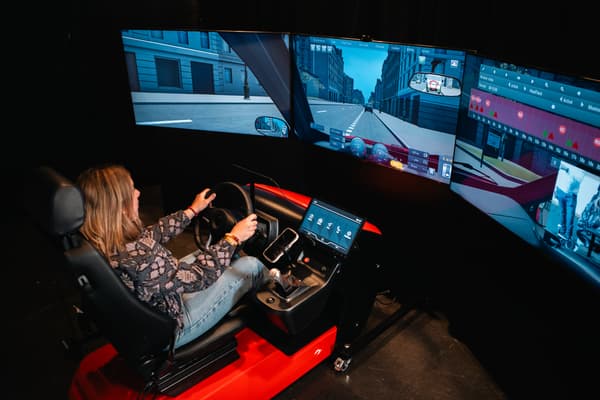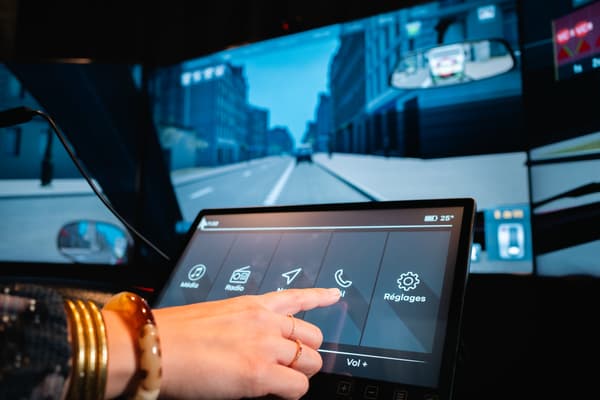Mobile phones while driving have been a scourge on the roads for many years. However, despite talk of prevention and increasingly severe sanctions, this practice does not seem to be on the decline.
In this context, the association Assurance Prévention wanted to assess the level of distraction with a unique scientific experiment, carried out under the supervision of the Calyxis risk expertise centre.
A unique scientific experiment
27 volunteer subjects, regular drivers and presented as “users of digital devices while driving”, each completed three journeys of more than 100 km in a driving simulator. More than 8,000 kilometres of driving in total, with and without distractions, as part of this driving situation in a simulator with driver eye tracking.

“On some sections of these journeys, drivers drove according to their habits, on others they were distracted (visual, auditory, physical and cognitive). These distractions were simultaneously integrated into the driving activity, via an on-board device, the only device authorised by the Highway Code,” Assurance Prévention said in a statement.
An important point to remember: this study therefore focused on uses via a touch screen integrated into the vehicle, and not with a phone in hand or on a stand. With practices that are authorised, such as making a call, and others that are prohibited or “simply” not recommended: such as typing a telephone number on this screen.
In fact, the law focuses primarily on the phone you are holding in your hand, but there is the same risk if you spend a lot of time with your smartphone fixed in a holder or on a screen integrated into the vehicle.

In fact, all these behaviours lead to physical distraction, as recently noted by Road Safety: “the driver no longer holds the steering wheel with both hands when dialling a number, sending a text or holding the phone in his hand.”
A trivialized use of “distractors”
First observation of this study: the use of distractions while driving has become commonplace. In fact, on the first route, drivers were free to use or not use digital devices (hands-free phone kit or vehicle touch screen), depending on their driving habits, thus reflecting their natural behaviour. Many then gave in to temptation: 3 out of 4 drivers (76%) used a distraction while driving during this first experience.
On the second route, drivers were subjected to “imposed light distractions” consisting of a conversation with the passenger, use of the radio with a station option, three incoming phone calls and following a route by GPS.
Finally, we found “strong imposed distractors” in the third way: a 10-minute outgoing phone call with a third party, followed by a search for music in a playlist, three outgoing phone calls (with dialing a number and searching in the directory), and then reading an SMS in a context of “different distractors” (radio, music and GPS).
35 seconds of inattention to write a number
The study thus made it possible to specifically evaluate certain effects of these distractors.
Dialing a number while driving causes, for example, 35 seconds of accumulated inattention, taking into account that the driver’s gaze alternates between the road and the screen.
Compared to a trip without these sources of distraction, where a driver constantly makes microcorrections, a trip with a distraction increases the time spent making deviations from the route by up to 13 times, which can lead to a change of direction.
Another worrying conclusion: “the use of distractions eliminates all safety controls (rearview mirrors and dashboard),” explains Assurance Prévention, and drivers “are then limited to going back and forth between the screen and the road.”
The results are not, of course, any more reassuring about emergency reflexes: “The use of a distractor increases the reaction time of drivers by 60%. It goes from 1.25 seconds on average in driving situations without a distractor to 2 seconds with a distractor.”
Some tips for safer travel
To limit the risks, Assurance Prévention recommends limiting the use of these distractions as much as possible. For the most addicted, why not put your phone in airplane mode during a trip or entrust it to a passenger?
It is also recommended to start your favorite playlist or a GPS route when stopping and before hitting the road.
On a long trip, don’t hesitate to plan regular breaks, enough to rest, get some fresh air, but also to be able to check your phone again in complete safety.
The association also invites relatives of drivers not to call or send messages when we know that the person is behind the wheel.
Source: BFM TV

